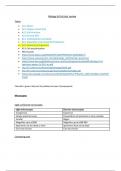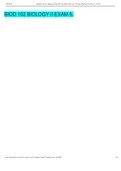Summary
Summary Biology ib SL and HL paper 1 and paper 2 review (with links and resources)
- Course
- Institution
- Book
The document goes in great detail about the ib biology SL and HL topics; Water, Origin of cells, cell structure, virsues, carbohydrates and lipids, organelles and compartementalization, diversity of organisms, membranes, cell specialization, stem cells etc. It's almost 200 pages of the topics descr...
[Show more]





